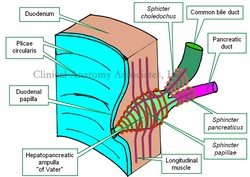The [sphincter of Oddi] is a complex system of smooth muscles that controls flow of bile and pancreatic juice into the duodenum. Although known by its eponym, this structure has the anatomical name of "sphincter of the hepatopancreatic ampulla". Although described previously by others, it was Ruggero Oddi (1864-1913) who described not only its structure, but also its function.
The hepatopancreatic ampulla or "ampulla of Vater" is a dilation found at the conjunction and end of the common bile duct and pancreatic duct. The presence of the hepatopancreatic ampulla creates a nipple-like elevation of the duodenal mucosa called the "duodenal papilla".
The sphincter of Oddi has several components:
- Sphincter papillae: This portion of the sphincter surrounds the papillary and intramural portion of the hepatopancreatic ampulla
- Sphincter choledochus: This portion of the sphincter surrounds the most distal portion of the common bile duct. It must be noted that this is the narrowest portion of the common bile duct, allowing for potential lodging of bile stones, cause for choledocholithiasis
- Sphincter pancreaticus: This portion of the sphincter surrounds the most distal portion of the pancreatic duct and prevents reflux of bile from the hepatopancreatic ampulla to the pancreatic duct.
The duodenal muscular layer parts to allow passage of the complex formed by the hepatopancreatic ampulla and the sphincter of Oddi, creating a window called the "choledochal window". Longitudinal fibers from the duodenal muscularis externa pass and join to the sphincter of Oddi.




